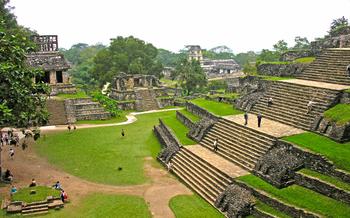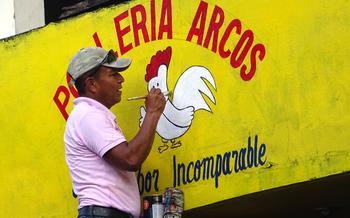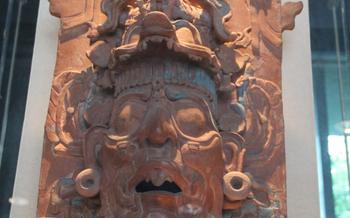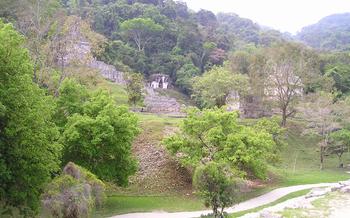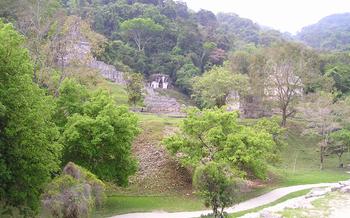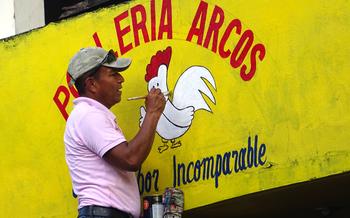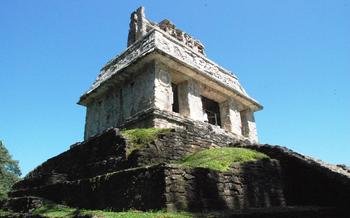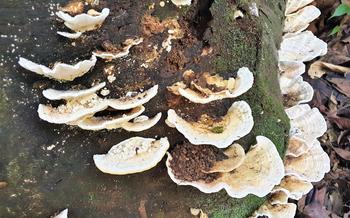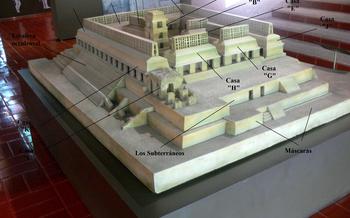
Group C Complex
- Palenque's Group C Complex: A Journey Through Ancient Mayan History
- Temple XXI: Unveiling the Secrets of the Sun God
- The Palace: A Glimpse into Mayan Royal Life
- Temple XVIII: Exploring the Complex's Oldest Structure
- The Red Palace: A Masterpiece of Mayan Architecture
- Temple of the Cross: Unveiling the Sacred Symbolism
- Temple of the Sun: Witnessing the Astronomical Alignments
- Temple of the Count: Exploring the Royal Lineage
- The Great Plaza: A Center of Mayan Social and Civic Life
- Ball Court: Unveiling the Rituals of the Ancient Game
- The Aqueduct: An Engineering Marvel of Ancient Times
- The Graffiti Wall: A Glimpse into the Lives of the Common People
- The Museum of Palenque: A Treasure Trove of Mayan Artifacts
- Insider Tip: Unforgettable Sunrise Views
Palenque's Group C Complex: A Journey Through Ancient Mayan History
The Group C Complex stands as a testament to the ingenuity and cultural richness of the ancient Mayan civilization. This complex, nestled within the lush greenery of Palenque, Mexico, offers a glimpse into the intricate world of the Mayans, their religious beliefs, and their architectural prowess. The complex boasts significant historical importance, as it served as the ceremonial and administrative center of the ancient Mayan city.
The Group C Complex encompasses several impressive structures, each contributing to the overall grandeur of the site. Among these structures are the imposing Temple XXI, the expansive Palace, the enigmatic Temple XVIII, the Red Palace, the sacred Temple of the Cross, the celestial Temple of the Sun, the dynastic Temple of the Count, and the central Great Plaza.
The complex is characterized by its unique architectural features, showcasing the Mayans' mastery of construction techniques. The use of corbelled arches, intricate carvings, and elaborate stucco decorations adds to the splendor of the site. The structures are adorned with symbolic representations and hieroglyphic inscriptions, providing insights into Mayan mythology, history, and religious practices.
The Group C Complex holds profound cultural and religious significance for the Mayans. It served as a sacred space for performing religious ceremonies, honoring deities, and commemorating important events. The complex's intricate designs and iconography reflect the Mayans' deep spiritual beliefs and their connection to the divine.
Temple XXI: Unveiling the Secrets of the Sun God
Architectural Grandeur and Unique Features: Temple XXI, also known as the Temple of the Sun, stands as a testament to the architectural prowess of the ancient Mayans. Its imposing structure rises majestically from the heart of the Group C Complex, drawing visitors with its sheer size and intricate details. The temple's pyramid-like design features a series of terraces leading to a small sanctuary at the summit. This unique layout offers a glimpse into the Mayan's advanced construction techniques and their ability to create monumental structures that defied the limitations of their time.
Intricate Carvings and Symbolic Representations: The exterior of Temple XXI is adorned with a mesmerizing array of carvings and sculptures, each holding a profound symbolic meaning. The intricate bas-reliefs depict mythological scenes, historical events, and representations of Mayan deities. Among the most striking carvings is the figure of the sun god, Kinich Ahau, whose radiant presence graces the façade of the temple. These elaborate carvings provide valuable insights into Mayan beliefs, mythology, and the significance of celestial bodies in their culture.
Historical Significance and Religious Importance: Temple XXI was dedicated to the worship of the sun god, Kinich Ahau, who held a central position in the Mayan pantheon. The temple served as a sacred site where Mayan priests performed elaborate rituals and ceremonies to honor the sun god and seek his blessings. The alignment of the temple with the summer solstice further emphasizes its astronomical significance. During this period, the rising sun perfectly illuminates the interior of the temple, casting a mystical glow that highlights the intricate carvings and creates a profound sense of awe and reverence.
Views from the Top of the Temple: Ascending the steep steps of Temple XXI leads to a small sanctuary at the summit, offering breathtaking panoramic views of the surrounding landscape. From this elevated vantage point, visitors can marvel at the sprawling expanse of the Group C Complex, the lush rainforest canopy, and the distant peaks of the Chiapas mountains. The panoramic views from the top of the temple provide a unique perspective and help visitors appreciate the scale and grandeur of this ancient Mayan city.
The Palace: A Glimpse into Mayan Royal Life
The Palace stands as a testament to the grandeur and sophistication of Mayan royal life. Its impressive architectural design reflects the power and authority of the Mayan rulers who resided within its walls. The Palace served as both a residential and administrative center, housing the royal family and their entourage while also facilitating the governance of the city.
Elaborate stucco decorations and paintings adorn the walls of the Palace, showcasing the artistic prowess and cultural significance of the Mayans. These intricate artworks depict scenes from Mayan mythology, historical events, and daily life, providing valuable insights into the beliefs, customs, and traditions of this ancient civilization.
A remarkable feature of the Palace is its ancient water system, a testament to the ingenuity and engineering skills of the Mayans. This complex system channeled water from nearby rivers and springs into reservoirs and fountains within the Palace, ensuring a reliable water supply for the royal household and the surrounding community.
Temple XVIII: Exploring the Complex's Oldest Structure
Temple XVIII stands as the oldest surviving structure within the Group C Complex, a testament to the enduring legacy of Palenque's ancient Mayan civilization. Its historical significance extends beyond its age, as it played a pivotal role in establishing the site's chronological timeline. This majestic temple boasts unique architectural features that set it apart from other structures within the complex. Its distinctive layout, characterized by a single room with two doorways, provides a glimpse into the evolving architectural styles of the Mayan civilization.
The temple's façade is adorned with intricate carvings and symbolic motifs, adding to its enigmatic charm. These carvings depict various deities, mythological scenes, and historical events, offering valuable insights into the rich cultural and religious beliefs of the ancient Mayans. The temple's contribution to understanding Mayan chronology is particularly noteworthy. Through careful analysis of its architectural features and associated artifacts, archaeologists have been able to pinpoint its construction date with remarkable accuracy. This has played a crucial role in establishing a comprehensive timeline for Palenque's development and solidifying its place in the wider context of Mayan history.
The Red Palace: A Masterpiece of Mayan Architecture
Amidst the architectural wonders of the Group C Complex, the Red Palace stands as a testament to the exceptional artistry and ingenuity of the ancient Maya. Its striking reddish hue, a result of the unique composition of the limestone used in its construction, sets it apart from the other structures within the complex.
The Red Palace showcases intricate carvings and symbolic representations that offer glimpses into the rich mythology and beliefs of the Maya. These carvings depict various deities, mythological scenes, and historical events, providing valuable insights into the cultural and religious significance of the structure.
Beyond its aesthetic beauty, the Red Palace also served an important functional purpose. It is believed to have been a residential palace for the Mayan rulers and their families, as well as a center for administrative and political activities. The presence of elaborate courtyards, living quarters, and audience chambers suggests the grandeur and opulence of the Mayan royal court.
The Red Palace stands as a testament to the architectural prowess and artistic achievements of the Maya. Its unique design, intricate carvings, and historical significance make it a must-visit attraction within the Group C Complex, offering visitors a glimpse into the grandeur and sophistication of ancient Mayan civilization.
Temple of the Cross: Unveiling the Sacred Symbolism
The Temple of the Cross is a remarkable structure within the Group C Complex, holding immense historical significance and religious importance. Constructed during the 7th century AD, it is renowned for its elaborate stucco decorations and symbolic carvings, which provide valuable insights into Mayan mythology and belief systems.
The temple's façade is adorned with intricate stucco reliefs depicting various mythological scenes and deities. One of the most notable carvings is the central figure, which represents the Mayan maize god known as "God L." This deity was associated with agriculture and fertility, playing a crucial role in Mayan religious practices.
The interior of the temple also features symbolic carvings and decorations. The walls are adorned with stucco panels depicting scenes of human sacrifice and ritual bloodletting. These graphic representations highlight the religious significance of the temple and the deep devotion of the Mayan people to their gods.
The Temple of the Cross derives its name from a large stone cross that was discovered at the base of the temple during excavations in the 19th century. The cross is an enigmatic symbol, as it predates the arrival of the Spanish conquistadors and their introduction of Christianity to the region. Some scholars believe that the cross may represent a sacred tree or a symbol of the four cardinal directions, holding significant meaning within Mayan cosmology.
Overall, the Temple of the Cross stands as a testament to the rich religious symbolism and artistic prowess of the ancient Mayans. Its intricate carvings and decorations offer a glimpse into the complex belief systems and rituals that shaped Mayan society.
Temple of the Sun: Witnessing the Astronomical Alignments
The Temple of the Sun is a remarkable structure within the Group C Complex, renowned for its celestial alignments and astronomical significance. Its architectural design is meticulously oriented to capture the sun's rays during specific times of the year, creating a captivating spectacle of light and shadow.
The temple's alignment with the sun's position during the spring and autumn equinoxes is particularly noteworthy. As the sun rises on these significant dates, its rays illuminate the main doorway, casting a brilliant glow that illuminates the interior of the temple. This alignment served as a celestial calendar for the ancient Mayans, marking the changing seasons and agricultural cycles.
In addition to its equinox alignments, the Temple of the Sun also aligns with the summer solstice. During this time, the sun's rays penetrate the temple's doorway and illuminate a carved stone disk, known as the "solar marker." This unique feature further emphasizes the temple's connection to celestial events and the importance of astronomy in Mayan culture.
Beyond its astronomical significance, the Temple of the Sun is adorned with intricate carvings and symbolic elements. The facade of the temple features a series of bas-relief panels depicting mythological scenes and deities associated with the sun and the underworld. These carvings provide valuable insights into Mayan religious beliefs and mythology, shedding light on their complex understanding of the cosmos and the interconnectedness of the natural and supernatural worlds.
Temple of the Count: Exploring the Royal Lineage
Nestled amidst the lush vegetation of Palenque's Group C Complex, the Temple of the Count stands as a testament to the rich dynastic history of the ancient Maya. This imposing structure, dating back to the 7th century AD, is dedicated to the memory of K'inich Janaab' Pakal, one of Palenque's most renowned rulers.
The temple showcases intricate stucco decorations and symbolic motifs that narrate the life and accomplishments of K'inich Janaab' Pakal. Elaborate carvings depict scenes of his accession to the throne, his military triumphs, and his alliances with other city-states. These intricate artworks provide valuable insights into the political and social dynamics of the Maya civilization during his reign.
The Temple of the Count also holds significance in understanding Mayan dynastic succession and lineage. It is believed that the temple served as a mortuary temple, housing the remains of K'inich Janaab' Pakal and his descendants. The discovery of his elaborately carved sarcophagus within the temple further reinforces its connection to the royal family of Palenque.
Exploring the Temple of the Count offers a unique opportunity to delve into the world of Mayan royalty, gaining a deeper appreciation for their complex political structures, dynastic lineage, and the reverence they held for their rulers.
The Great Plaza: A Center of Mayan Social and Civic Life
The Great Plaza, situated at the heart of the Group C Complex, served as the central gathering space and focal point of Mayan social and civic life. Encompassing an expansive area, the plaza was bordered by magnificent structures, including temples, palaces, and administrative buildings, creating an awe-inspiring architectural ensemble. Its vast dimensions allowed for the congregation of large crowds during religious ceremonies, political events, and market days. The plaza functioned as a vibrant marketplace where merchants from distant regions gathered to trade goods, exchange ideas, and foster cultural connections. It also served as a venue for public gatherings, celebrations, and the enactment of important rituals that reinforced the unity and cohesion of the Mayan community. This central plaza, with its intricate layout and symbolic significance, stands as a testament to the advanced urban planning and sophisticated social organization of the ancient Maya.
Ball Court: Unveiling the Rituals of the Ancient Game
Amidst the awe-inspiring structures of the Group C Complex, the ball court stands as a testament to the significance of sports and rituals in ancient Mayan society. With its elongated shape and sloped sides, the court provided a dynamic space for the ritualistic ball game played by the Mayans.
The ball court's architectural features are meticulously designed to enhance the game's intensity and symbolism. The sloped sides and narrow playing area create a challenging environment, requiring players to possess both agility and skill. The acoustics of the court amplify the sounds of the ball bouncing, creating an immersive atmosphere that heightens the excitement of the game.
Beyond its physical attributes, the ball court holds profound cultural and religious significance for the Mayans. The game was not merely a form of entertainment but a sacred ritual deeply intertwined with their beliefs and traditions. The ball represented the sun, and the game itself symbolized the cosmic struggle between light and darkness.
Victories in the ball game were considered auspicious omens, and players were often revered as heroes and intermediaries between the mortal and divine realms. The court served as a sacred space where the Mayans could connect with their gods and ancestors through the medium of sport.
The Aqueduct: An Engineering Marvel of Ancient Times
The ancient Mayans of Palenque were not only skilled architects and artisans but also impressive engineers. One of the most remarkable testaments to their engineering prowess is the Group C Complex's intricate aqueduct system. This sophisticated network of channels and reservoirs provided a vital water supply to the city's inhabitants, showcasing their ingenuity in managing and distributing water resources.
Built with meticulous precision, the aqueduct relied on gravity to transport water from distant springs to reservoirs within the complex. The system included a series of underground channels, stone conduits, and elevated aqueducts, some of which still stand today. By harnessing the natural flow of water, the Mayans ensured a reliable and consistent supply for drinking, bathing, and irrigation purposes.
The aqueduct's construction required a deep understanding of hydraulics and engineering principles. The Mayans carefully selected the routes of the channels to minimize water loss and maintain a steady flow. They also employed techniques such as terracing and leveling to ensure the water's smooth passage. The system's durability and effectiveness are a testament to the Mayans' advanced engineering capabilities.
Exploring the remains of the aqueduct is a fascinating journey into the minds of ancient engineers. Visitors can trace the course of the channels, marvel at the intricate stonework, and appreciate the ingenuity behind this essential infrastructure. The aqueduct serves as a reminder of the Mayans' remarkable achievements in water management and engineering, leaving a lasting legacy of innovation and sustainability.
The Graffiti Wall: A Glimpse into the Lives of the Common People
The Graffiti Wall, discovered in the 1960s, stands as a unique testament to the lives of ordinary Mayans who inhabited Palenque. Unlike the elaborate carvings and inscriptions found in other parts of the complex, the Graffiti Wall features simpler drawings and writings etched into the plaster walls. These informal markings offer a rare glimpse into the daily lives, customs, and beliefs of the common people who once lived in the city.
The Graffiti Wall showcases a diverse range of subjects, from everyday scenes and activities to religious symbols and mythological figures. Simple drawings depict people engaged in hunting, fishing, farming, and other daily tasks, providing insights into the livelihoods and occupations of the ancient Mayans. The wall also features names, dates, and personal messages, offering a glimpse into the social interactions and relationships within the community.
The Graffiti Wall holds immense significance in understanding the social structure and cultural practices of the Mayan civilization. It reveals the existence of a vibrant and diverse society, where people from different backgrounds and walks of life contributed to the richness of Mayan culture. Through these simple markings, we gain a deeper appreciation for the lives of the common people who played a vital role in shaping the history of Palenque.
The Museum of Palenque: A Treasure Trove of Mayan Artifacts
The Museum of Palenque, located in the heart of the archaeological site, is a treasure trove of Mayan artifacts and a testament to the rich cultural heritage of this ancient civilization. Established in 1981, the museum houses a vast collection of archaeological finds unearthed during excavations at Palenque and the surrounding region.
As you step into the museum, you'll be greeted by an array of exhibits that showcase the artistry, craftsmanship, and ingenuity of the ancient Mayans. Among the highlights of the collection are intricate stone carvings, ceramic vessels, jade ornaments, and stucco sculptures, each offering a glimpse into the daily life, religious beliefs, and artistic traditions of this enigmatic civilization.
One of the most captivating exhibits is the funerary mask of Pakal the Great, the most famous ruler of Palenque. Crafted from jade and adorned with intricate carvings, this masterpiece of Mayan craftsmanship is a testament to the power and prestige of this legendary king.
The museum also features a collection of artifacts related to the everyday lives of the ancient Mayans, including tools, utensils, and pottery. These items provide insights into their agricultural practices, culinary traditions, and domestic life.
Through its comprehensive collection and informative exhibits, the Museum of Palenque offers visitors a unique opportunity to delve into the rich history and culture of the ancient Mayans. It's a must-visit destination for anyone interested in exploring the mysteries and marvels of this ancient civilization.
Insider Tip: Unforgettable Sunrise Views
The optimal time to visit the Group C Complex is during the early morning hours, as the rising sun casts a magical glow upon the ancient structures, creating a breathtaking spectacle. As the first rays of sunlight illuminate the complex, the intricate carvings and towering pyramids come to life, revealing the splendor of Mayan architecture. This is the perfect time to capture stunning photographs that will forever immortalize your visit to Palenque.
The atmosphere at sunrise is serene and tranquil, offering a unique opportunity to connect with the ancient Mayan civilization in a profound way. With the absence of crowds, you can wander through the complex at your own pace, absorbing the beauty and grandeur of the surroundings. Whether you choose to stand in awe at the foot of Temple XXI or climb to the top of the Red Palace for panoramic views, the sunrise at Palenque is an experience that will leave an unforgettable mark on your soul.
For the best sunrise views, head to the Great Plaza or the Temple of the Cross. These vantage points offer breathtaking vistas of the complex as the sun rises over the horizon. Be sure to bring your camera and tripod to capture the magical moment when the first rays of light illuminate the ancient city. The resulting photographs will be a cherished reminder of your time in Palenque, a place where history and beauty converge.
